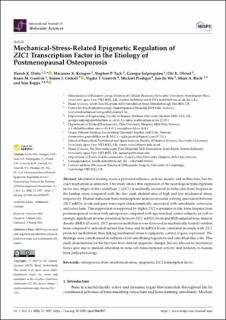| dc.contributor.author | Datta, Harish K. | |
| dc.contributor.author | Kringen, Marianne K. | |
| dc.contributor.author | Tuck, Stephen P. | |
| dc.contributor.author | Salpingidou, Georgia | |
| dc.contributor.author | Olstad, Ole K. | |
| dc.contributor.author | Gautvik, Kaare M | |
| dc.contributor.author | Cockell, Simon | |
| dc.contributor.author | Gautvik, Vigdis Teig | |
| dc.contributor.author | Prediger, Michael | |
| dc.contributor.author | Wu, Jun J. | |
| dc.contributor.author | Birch, Mark A. | |
| dc.contributor.author | Reppe, Sjur | |
| dc.date.accessioned | 2022-03-10T10:14:59Z | |
| dc.date.available | 2022-03-10T10:14:59Z | |
| dc.date.created | 2022-03-09T15:50:49Z | |
| dc.date.issued | 2022 | |
| dc.identifier.citation | International Journal of Molecular Sciences. 2022, 23 (2957), . | en_US |
| dc.identifier.issn | 1661-6596 | |
| dc.identifier.uri | https://hdl.handle.net/11250/2984208 | |
| dc.description.abstract | Mechanical loading exerts a profound influence on bone density and architecture, but the exact mechanism is unknown. Our study shows that expression of the neurological transcriptional factor zinc finger of the cerebellum 1 (ZIC1) is markedly increased in trabecular bone biopsies in the lumbar spine compared with the iliac crest, skeletal sites of high and low mechanical stress, respectively. Human trabecular bone transcriptome analyses revealed a strong association between ZIC1 mRNA levels and gene transcripts characteristically associated with osteoblasts, osteocytes and osteoclasts. This supposition is supported by higher ZIC1 expression in iliac bone biopsies from postmenopausal women with osteoporosis compared with age-matched control subjects, as well as strongly significant inverse correlation between ZIC1 mRNA levels and BMI-adjusted bone mineral density (BMD) (Z-score). ZIC1 promoter methylation was decreased in mechanically loaded vertebral bone compared to unloaded normal iliac bone, and its mRNA levels correlated inversely with ZIC1 promoter methylation, thus linking mechanical stress to epigenetic control of gene expression. The findings were corroborated in cultures of rat osteoblast progenitors and osteoblast-like cells. This study demonstrates for the first time how skeletal epigenetic changes that are affected by mechanical forces give rise to marked alteration in bone cell transcriptional activity and translate to human bone pathophysiology | en_US |
| dc.language.iso | eng | en_US |
| dc.rights | Navngivelse 4.0 Internasjonal | * |
| dc.rights.uri | http://creativecommons.org/licenses/by/4.0/deed.no | * |
| dc.subject | Osteoporosis | en_US |
| dc.subject | Mechanical stress | en_US |
| dc.subject | Epigenetic | en_US |
| dc.title | Mechanical-stress-related epigenetic regulation of ZIC1 transcription factor in the etiology of postmenopausal osteoporosis | en_US |
| dc.type | Peer reviewed | en_US |
| dc.type | Journal article | en_US |
| dc.description.version | publishedVersion | en_US |
| cristin.ispublished | true | |
| cristin.fulltext | original | |
| cristin.qualitycode | 1 | |
| dc.identifier.doi | 10.3390/ijms23062957 | |
| dc.identifier.cristin | 2008590 | |
| dc.source.journal | International Journal of Molecular Sciences | en_US |
| dc.source.volume | 23 | en_US |
| dc.source.issue | 2957 | en_US |
| dc.source.pagenumber | 18 | en_US |

